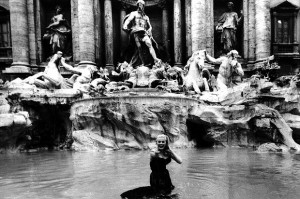WHEN IN ROME: 2 STARS
The good part of “When in Rome,” the new Kristen Bell film, is that it doesn’t follow the usual unlikely boy-meets-unlikely-girl romantic comedy set-up. The bad part is that just because it doesn’t follow the usual rom com rules doesn’t mean it isn’t predictable.
Bell is Beth, a work obsessed curator at the Guggenheim Museum in NYC. After her last boyfriend “ripped out her heart and fed it to the pigeons in Central Park” she lost faith in romance but when her sister impulsively decides to get married in Italy Beth reluctantly takes a couple of days off, where she ends up drunk in the “fountain of love” plucking coins from the water. Little does she realize that an old legend declares that when you take coins from the fountain, you take the heart of the person who tossed the coin in the fountain in the first place. Soon she is being unwillingly courted by four men—an artist, a street magician, a sausage salesman, a model and willingly courted by Nick (Josh Duhamel), an ex football star. The question is, “Is the love for real or just a magic spell?”
“When in Rome” is as frothy as it gets. It’s a romantic fantasy with no foot in reality. In fact, the only fantasy here is that anybody thought this was a strong enough idea to carry a whole movie. There are a few laughs sprinkled throughout and the audience I saw this with laughed intermittently, but the jokes—like an Italian priest mispronouncing “lawfully wedded wife” as “awfully wedded wife” not once, but twice!—are more amusing than actually funny.
The movie does earn some legit laughs—a tiny European car gag is silly fun—from the more comic savvy members of the cast like Will Arnett, Danny DeVito and Dax Shepard, (Jon “Napoleon Dynamite” Heder continues his string of more annoying than funny performances), but when the attention shifts away from them to the leads “When in Rome” flat lines.
Bell’s idea of physical comedy is to smile with spinach in her teeth and while she’s an agreeable screen presence she isn’t really suited for this kind of comedy. Ditto Don Johnson who plays her father. The years have been kind to Johnson, but he doesn’t have a natural gift for comedy. As for Anjelica Huston as Beth’s testy Guggenheim head curator… well let’s just say I choose to remember her glory days in films like “The Grifters” and “Prizzi’s Honor.”
Josh Duhamel fares slightly better. He’s the charming (but slightly goofy) single guy with the perfect bachelor pad—complete with a barber’s chair, a pinball machine and neon cocktail sign—who can deliver a joke well enough but appears to me to be a modern day Tab Hunter; more male model than an interesting actor.
“When In Rome” is further proof that romantic comedy needs a shot in the arm. A few weeks ago, on the release of “Leap Year,” I suggested that someone like Quentin Tarantino should come in and completely reboot the genre. Seeing “When in Rome” didn’t change my mind.

